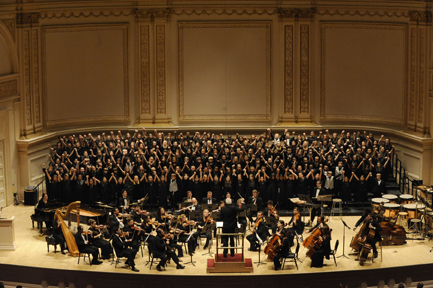A Concert for Healing & Hope
Distinguished Concerts Orchestra International
Distinguished Concerts Singers International
Carnegie Hall: Stern Auditorium, New York, NY
June 6, 2010
This unusual concert was less a musical than an emotional event. The first of its two parts (each of which could have filled an entire program), was called “Heartsongs” and celebrated the life and poetry of Mattie Stepanek, who died just before his 14th birthday of a rare neuromuscular disease; his words were set to music by Joseph Martin. Pamela Martin Tomlinson provided the text for the second part, called “Sing for the Cure”: ten poems, linked by a narration, based on stories told by breast cancer survivors and the families of those who died. The musical settings were by ten composers: Michael Cox, Alice Gomez, Rosephanye Powell, Robert Seeley, Jill Gallina, Patti Drennan, Stefania de Kennessey, David Friedman, W.T Greer III, and Joseph Martin.
Receiving its world premiere, “Heartsongs” was performed by six children’s choruses from Texas, Mississippi and Tennesee, conducted competently but a bit phlegmatically by Stephen Roddy; “Sing for the Cure” featured four adult choruses from Ohio, Florida, Georgia, and Texas, conducted with enormous verve, authority and involvement by Timothy Seelig. Getting all these choruses from so many places together must have been a formidable undertaking. With their parts thoroughly learned, they congregated two days before the performance in New York, where the children’s and adults’ choirs each rehearsed for eight hours.
The children, singing from memory, were accompanied by a small orchestra, the adults by a huge one; its percussion section, manned by four players, contained not only five timpani of different sizes, but seemed to include every percussion instrument known to mankind. The stage was full to bursting, producing an impressive visual effect that was further enhanced by the singers’ clothes: the children’s were black, but, for reasons unexplained, a few boys wore silver vests; the adults’ were multi-colored; all wore long pink scarves.
The music, with its simple, semi-popular tunes usually doubled by voices and instruments would have been more at home in a Hollywood studio than a New York concert hall. Martin’s “Heartsongs” included adaptations of spirituals and a conflation of “Simple Gifts” with the famous theme from Dvorák’s “New World” Symphony. The vocal writing was almost entirely in unison; the majority of the songs were slow. In the second part, the unison was partly replaced by thirds and sixths, and there was more variety of tempo and character. The most successful songs were those derived from waltzes, blues, gospel shouts and jazz, with the singers swaying lustily to the rhythms. Numerous impressive soloists stepped out from the chorus, singly and in groups.
The orchestra was a tower of strength, offering solid, sensitive, but unobtrusive support. In addition to the percussionists, special praise is due to concertmaster Jorge Avila, who played many demanding, stratospheric solos brilliantly, and to pianist Russ Rieger, who provided what sounded like an improvised background to the second part’s narration, subtly modulating from one song to the next.
But there was no doubt that the evening’s primary impact came from its literary and human components. Mattie Stepanek’s “Heartsongs” were introduced by his mother, who is herself suffering from the same disease and came on stage in a wheelchair, with a ventilator, accompanied by her service dog. Mattie reportedly started writing poems at the age of three and never stopped. Expressing hope, faith, and a deep appreciation of nature and beauty, they were described as “inspirational” and were clearly “inspired” by what he heard from the people around him, who must have been extraordinary themselves. In addition to being sung, the poems were read and narrated by two famous rock stars, Nile Rodgers and Billy Gilman.
Pamela Tomlinson’s words were narrated by Rene Syler, a cancer survivor. They described the reactions of cancer patients to the various stages of their illness, and also the responses of their families to the roller-coaster of hope, despair and loss. Perhaps most wrenching were several sections focusing on mothers and children. In one, an adult daughter recounted a recurrent dream of being visited by the mother she lost as a child; it must have broken the hearts of everyone present, not only those who have lost a mother.

